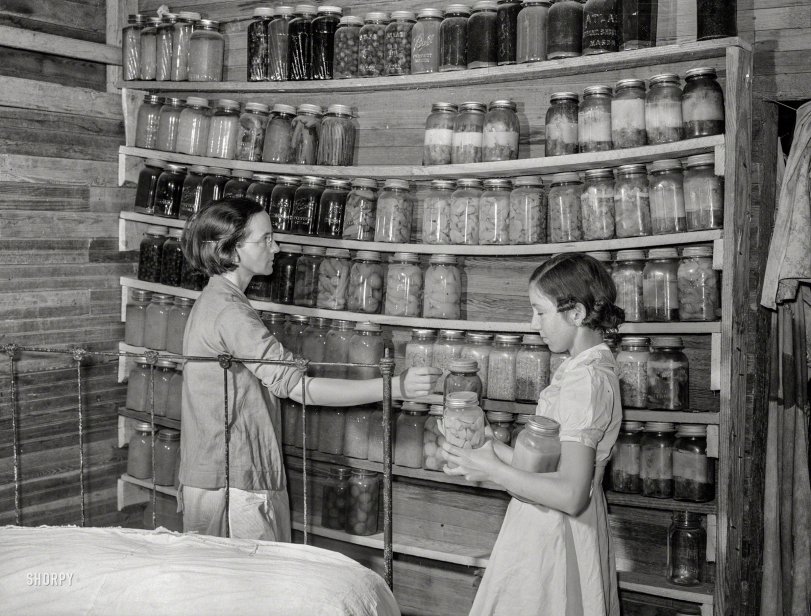


Framed or unframed, desk size to sofa size, printed by us in Arizona and Alabama since 2007. Explore now.
Shorpy is funded by you. Patreon contributors get an ad-free experience.
Learn more.

- Baldwin 62303
- Baldwin VO-1000
- Cold
- No expense spared
- Tough Guys
- Lost in Toyland
- And without gloves
- If I were a blindfolded time traveler
- Smoke Consumer Also Cooks
- Oh that stove!
- Possibly still there?
- What?!?
- $100 Reward
- Freeze Frame
- Texas Flyer wanted
- Just a Year Too Soon
- WWII -- Replacing men with women at the railroad crossing.
- Yes, Icing
- You kids drive me nuts!
- NOT An Easy Job
- I wonder
- Just add window boxes
- Icing Platform?
- Indiana Harbor Belt abides
- Freezing haze
- Corrections (for those who care)
- C&NW at Nelson
- Fallen Flags
- A dangerous job made worse
- Water Stop
Print Emporium
Can Much?

April 1939. Coffee County, Alabama. "Mrs. Peacock and daughter Mary, Rural Rehabilitation clients for four years, getting some of their supply of canned foods for dinner. Many families keep their jars on shelves along wall in bedroom and living room." Acetate negative by Marion Post Wolcott. View full size.
Figured out!
The complex solution:
1. Tear down the shelves.
2. Rebuild them with greater strength and stiffness.
The medium effort solution:
1. Remove jars.
2. Add vertical in the middle.
3. Put jars back.
The practical solution:
1. Remove jars.
2. Reload the shelves from the bottom up. Put the jars that will be consumed last in first and bottommost.
3. Add shims on top of jars if and where required. The center jars would give themselves to being shimmed.
4. Consume jars from top down.
5. Wash, rinse and repeat if and when new jars are added.
Anyone figured out
the very simple solution to prevent the sagging shelves now and when it was built?
Ball Curve
It's like a Bell curve, only upside down.
(the 'triple layer' effect looks like a layer of fat that has congealed. Whatever was canned was probably cooked with hog jowls or other meat for flavoring.)
Triple layer
What is inside the triple-layer jars on the second shelf from the top? And while we’re at it, I’ve always wondered about those chunky bits in the jars directly underneath. Someone please do the contents ID!
Deflection y at any given point x from one end
The standard formula for finding deflection y at any given point from one end, say from LHS, is given by:
y = [wx(L-x)/24EIL][L**2+x(L-x)]...(1)
where:
E : Young’s modulus of elasticity of the material from which the beam is fabricated (N/m2)
I : Area Moment of Inertia (m4)
L : Total length of the beam measured between centres of support (m)
x : Some distance from one side of the beam, say from LHS (m)
w : Load (N or kN)
clearly shows that jars should be removed from the ends rather than from the middle.
Suspense
I wonder if any newspaper reported what happened to the shelves.
I can't even
Whoa! The Peacocks will no doubt make it through the winter, but I'm not too sure about those shelves. I can hear them groaning across the decades, under the weight of all those goodies. Well done, ladies.
Warpage
I'm getting nervous just looking at this — of all the time travel fantasies elicited by looking through this site, the desire to reach out a hand and prop up those shelves might be the most pressing.
Heavy, man
I figure about 3 pounds per jar and about 300 pounds for the entire wall.
























On Shorpy:
Today’s Top 5